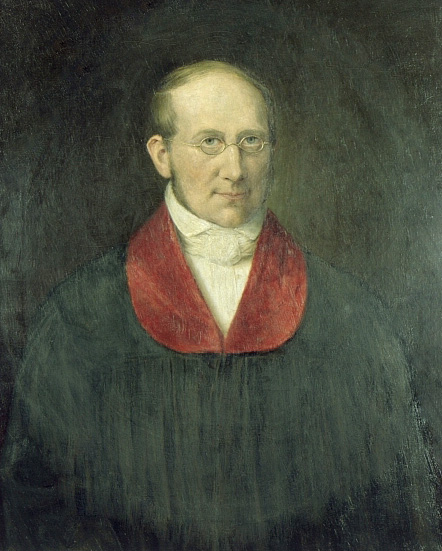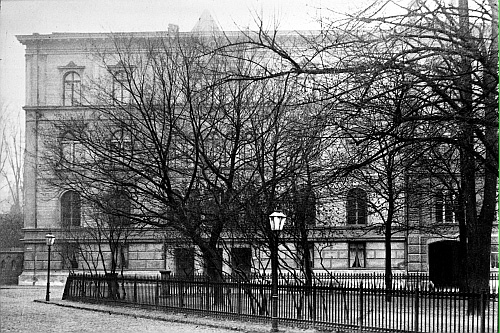1827
On 24 March 1827 a new settlement was reached between the sovereign and the City of Rostock. In this settlement, among other agreements “for the improvement of the city’s assets”, it was stipulated that the joint funding (“Kompatronat”) for the University to which the town was entitled would be taken over by the Grand Duke. In August 1827 the Regulatory Order was signed, under which the city transferred all rights contained in the inheritance contract of 1788 to the University and transferred the Kompatronat which, up to then, had been the responsibility of the sovereign. The city was exempted from all warranties for the University and was also “never to be obliged to make a financial contribution to the University”.
The city transferred all rights and powers over the University to the sovereign. This was the end of the Kompatronat, which had existed since 1563.
The city took over the obligation to make the ceremonial hall in the City Hall available for academic events. On the other hand, the University was not to make demands on the city for the provision of an auditorium (to replace the demolished Auditorium Magnum building).
1834
The students were dismissed from academic jurisdiction and placed under the control of the city authorities.
Formation of a Finance Commission to complete the nationalisation of the academic assets. The University was now a “special corporation recognised by the state” and, in every sense, a State University. Construction of a courtyard building to become the main University building for the chemical laboratory (Prof. von Blücher).
Source: 575 Jahre Universität Rostock. Mögen viele Lehrmeinungen um die eine Wahrheit ringen. Rostock 1994, S. 335-336.
Further reading:
Hückstädt, Arnold: Fritz Reuter und die "Allgemeinheit", John Brinckman und die "Gesellschaft der Volksfreunde". Rostocker Studentenverbindungen zwischen 1831 und 1834. In: Brunners, Christian (Hg.): Fritz Reuter, John Brinckman, Dethloff Carl Hinstorff und Rostock. Rostock 2002, S. 8-24.
Jügelt, Karl-Heinz: Bibliotheca Philosophica - Bibliotheca Academica - Universitätsbibliothek. Bücher, Bibliothekare und Ereignisse in der 425jährigen Geschichte der Universitätsbibliothek Rostock. In: Mögen viele Lehrmeinungen um die eine Wahrheit ringen. Hrsg. vom Rektor der Universität Rostock. Rostock 1994, S. 40-69.
1836
Government Plenipotentiary von Both was appointed Vice-Chancellor (Curator). He created the conditions for possible independence for the University and cleared the way for effective funding.
1838
Extension of the courtyard building built in 1834 for the Institute of Zootomic Physiology, founded by Prof. Hermann Stannius. Hermann Stannius began lessons in comparative anatomy, physiology and general pathology.
1841
Foundation of the Department of Homiletics and Catechesis; transformation of the Department of Theology and Pedagogy, founded in 1790, with a new remit.
1844
Completion of the “Neues Museum” as an annex to the main University building (architectural plans by Demmler). It housed the scientific facilities of the Chemical Laboratory, the Office of Mathematics and Physics and the zoological collection.
The Anatomical Institute was moved to the vacated courtyard building, its building in the Alter Markt having become unusable.
At the beginning of industrialisation in Mecklenburg, when an increase in the number of students began to emerge, the University ran the risk of being dissolved. The state government seriously considered setting up an agricultural school instead of a university. However, the Grand Duke was convinced that the University had to be preserved for the state.
1848
In addition to two petitions from the citizens of Rostock to the state government, a petition from the Rector and the Council on political procedures was passed on 12 March 1848. The University advocated “further constitutional development” of the (estate) constitution. The petitions were successful. A broad reform movement emerged, in which professors and students of the University participated; a new state parliament was elected and a constitution was drawn up.
07.03.1848
The supreme supervision of universities by an extraordinary government representative on the basis of the Carlsbad Decrees of 1819 was abolished.
Source: 575 Jahre Universität Rostock. Mögen viele Lehrmeinungen um die eine Wahrheit ringen. Rostock 1994, S. 336-337.
Further reading:
Boeck, Gisela; Lammel, Hans-Uwe (Hg.): Wissen im Wandel. Disziplinengeschichte im 19. Jahrhundert. Referate der interdisziplinären Ringvorlesung des Arbeitskreises "Rostocker Universitäts- und Wissenschaftsgeschichte" im Wintersemester 2007/08. Rostock 2011 (Rostocker Studien zur Universitätsgeschichte, 12). LINK
Stieda, Wilhelm: Hermann Stannius und die Universität Rostock 1837-1854. In: Mecklenburgische Jahrbücher, Bd. 93 (1929), S. 1-36.
Wischhusen, Heinz Günther: Friedrich Hermann Stannius (1808-1883) als Begründer des Instituts für vergleichende und allgemeine pathologische Anatomie sowie für Physiologie in Rostock (1838). In: Wissenschaftliche Zeitschrift der Universität Rostock, N-Reihe, Bd. 23 (1974), 4, S. 112-125.
1849
On 23 August, the Grand Duke signed the Basic State Law drawn up by the constitutional state parliament (Landtag), and the Estates Constitution was repealed on 10 October 1849.
1850
The sovereign and the knighthood overthrew the constitutional government, and on 1 July 1850 the state parliament was dissolved. In September, the Freienwald Arbitration Court announced that the repeal of the Estates Constitution and the new Basic State Law were not lawful. All hopes of a constitutional amendment were destroyed. The Basic Law on Inheritance Settlement (“Landesgrundgesetzliche Erbvergleich”) of 1755 was again the highest law.
1850
Vice-Chancellor von Both filed an application for discharge from the judicial service on health grounds and finally resigned on 6 September 1851. He was now available for the job of Curator of the University without any other obligations.
1852
In a persecution campaign against all democrats (the Persecution of the Demagogues), Professors Carl Türk, Julius Wiggers and Christian Wilbrandt were dismissed from their teaching posts on 7 July 1852. They were sentenced to imprisonment in the subsequent treason trial of 1853. The University, which still supported the reform movement of 1848, submitted without argument.
1852-1855
Construction of the Municipal Hospital in the Schröderplatz, whose medical care was taken over by the University. The first director was Prof. Carl Strempel. He had established a private clinic in 1828, and this had become the Municipal Hospital after the demolition of the hospital for the poor in the Grube in 1846. The clinic in Schröderplatz was taken over by the state in 1900 and handed over to the University.
Source: 575 Jahre Universität Rostock. Mögen viele Lehrmeinungen um die eine Wahrheit ringen. Rostock 1994, S. 337-338.
Further reading:
Baudis, Klaus: Ein Rostocker Historiker in den Kämpfen der Revolution von 1848/49 - Zum Wirken von Prof. Karl Türk in Rostock und Mecklenburg. In: Stutz, Reno (Hg.): Demokraten und ihre Gegenspieler. Norddeutsche in der Revolution von 1848/49. Rostock 2000, S. 137-145.
Manke, Matthias: Rostock zwischen Revolution und Biedermeier. Alltag und Sozialstruktur. Rostock 2000.
Meves, Uwe: Zu den Auswirkungen der Revolution von 1848 auf den Institutionalisierungsprozeß des Faches Deutsche Philologie. Am Beispiel der Universitäten Leipzig, Rostock, Bonn und Tübingen. In: Jaehrling, Jürgen; Meves, Uwe; Timm, Erika (Hg.): Röllwagenbüchlein. Festschrift für Walter Röll zum 65. Geburtstag. Tübingen 2002, S. 1-19.
Stutz, Reno: Revolutionsführer. Auf den Spuren der Revolution von 1848/49 in Rostock. Rostock 1998.
1866
Prussia concluded a treaty with 17 North German states, which became the basis for the North German Confederation, and secured its supremacy. The foundation of the Confederation was the essential basis for the Unification of the Reich in 1871.
1867
Laying of the foundation stone for the new main building. The Grand Duke handed over the official golden chain to the Rector.
1870
Completion of the main university building, inaugurated on 27 March 1870. Vice-Chancellor von Both (born 1789, honorary DPhil. and LL.D., honorary citizen of the city) ended his employment for health and age reasons. His successor was Maximilian von Liebeherr, President of the Regional Court and Consistorial President, who remained in office until his death in 1896.
1878
Completion of the Medical Institute building in Gertrudenstrasse (Anatomical Institute, physiology, pathology, hygiene).
1879
The academic jurisdiction, which, since 1870, had been practised merely as a medieval relic, was finally abolished with the National Justice Reform of 1879. Only disciplinary jurisdiction remained.
Source: 575 Jahre Universität Rostock. Mögen viele Lehrmeinungen um die eine Wahrheit ringen. Rostock 1994, S. 338-339.
Further reading:
Bartels, Olaf: Das Hauptgebäude der Universität in Rostock. In: Bartels, Olaf: Der Architekt Hermann Willebrand 1816-1899. Hamburg u.a. 2001, S. 67-71.
Bienengräber, Volker: 100 Jahre Lehrstuhl für allgemeine und spezielle Pathologie in Rostock. Der Beitrag des Rostocker Instituts an der Entwicklung der Pathologie und der neuen Arbeitsmöglichkeiten und Aufgaben des Instituts nach seiner Reorganisierung in den Jahren 1958-1965; zugleich eine historische Rückschau auf das Institut zum 550. Gründungsjubiläum der Universität Rostock (1969). In: Wissenschaftliche Zeitschrift der Universität Rostock, N-Reihe, 14 (1965), 1/2, S. 1-34.
Hennighausen, Gerhard: Pharmakologie und Toxikologie an der Universität Rostock seit 1865. Zum 125jährigen Bestehen des Lehrstuhls für Pharmakologie an der Universität Rostock. Rostock 1990.
Klausch, B.; Schwarz, R.: Die Geschichte der Frauenklinik der Universität Rostock von den Anfängen bis zur Gegenwart. Rostock 1980.
Mahnke, Reinhard: Ludwig Matthiessen, der erste ordentliche Professor der Physik an der Universität Rostock 1874-1905. In: Wissenschaftliche Zeitschrift der Universität Rostock, 34 (1985), 1, S. 74-86.
Mahnke, Reinhard: Zur Entwicklung der Physik an der Rostocker Universität. Rostock 1991.
Meves, Uwe: Karl Bartsch und die Gründung des ersten germanistischen Seminars (Universität Rostock 1858). In: Gärtner, Kurt; Lemmer, Manfred (Hg.): Von lon der Wisheit. Gedenkschrift für Manfred Lemmer. Sandersdorf 2009, S. 154-175.
Schultz, Helga; Heitz, Gerhard; Olechnowitz, Karl-Friedrich: Die Entwicklung geschichtswissenschaftlicher Studien an der Universität Rostock seit dem Ende des 18. Jahrhunderts. In: Wissenschaftliche Zeitschrift der Universität Rostock, G-Reihe 19 (1970), 5, S. 355-375.
Uerckwitz, Jürgen: Die Geschichte des Hygiene-Institutes der Universität Rostock, Diss. Rostock 1969.
1885-1887
New building of the gynaecological clinic in Doberaner Strasse, formerly Buchbinderstrasse; vacated rooms were taken over by the Institute of Hygiene in 1887 and by the Institute of Chemistry in 1888.
1899
Opening of the new building for the ENT clinic, Doberaner Straße. Today the clinic bears the name of the first professor for ENT diseases in Germany, Otto Körner (in Rostock 1894-1929).
1899
The church of the Monastery of the Holy Cross (Zum Heiligen Kreuz) was handed over to the University and became the University church.
1907
Opening of the dermatological clinic, Schröderplatz.
The Dental Institute of Johannes Reinmöller is established.
1909
Matriculation of the first female student, Elisabeth Bernhöft. The University of Rostock was thus the last in Germany to admit women to courses.
1917
Adoption of the Luftwarte (Air Station - Institute of Physics), which had existed since 1912 (until 1945).
1918
Following the military defeat and the economic and political collapse at the end of the First World War (1914-1918), the bourgeois-democratic November Revolution of 1918 overthrew the princely throne, and Mecklenburg's estates constitution came to an end.
The abdication of the Grand Duke of Mecklenburg also marked the end of the chancellorship of the University exercised by the respective ruler (de facto since the Reformation, de jure since the Peace of Münster in 1648). The University was now anxious to strengthen its self-government. A large number of the University reform proposals that emerged in this and the following period were aimed at this goal.
Source: 575 Jahre Universität Rostock. Mögen viele Lehrmeinungen um die eine Wahrheit ringen. Rostock 1994, S. 339-340.
Further reading:
Beese, Marianne; Knittel, Pirina; Stunnack, Grit: Geschichte des Frauenstudiums in Rostock - von den Anfängen bis zum Ende des Zweiten Weltkrieges. Rostock 1999.
Gottwald, Helmut: Zur Geschichte der Universitäts-Augenklinik Rostock. Rostock 1969.
Gross, Gerd (Hrsg.): 100 Jahre Universitäts-Hautklinik und Poliklinik Rostock. Rostock 2002.
Kramp, Burkhard; Jerecinski, Antje: Otto Körner: Arzt, Hochschullehrer und Forscher; erster deutscher Ordinarius für Ohren- und Kehlkopfkrankheiten und Gründer der ersten HNO-Fachklinik Nord- und Mitteleuropas. [Roggentin] 2010.
Krüger, Kersten (Hg.): Frauenstudium in Rostock. Berichte von und über Akademikerinnen. Rostock 2010 (Rostocker Studien zur Universitätsgeschichte, 9). LINK
Külz, Jürgen: Die Geschichte der Kinderheilkunde und der Kinderklinik an der Universität Rostock. Rostock 1993. (BGUR 18).
Mahnke, Reinhard: 100 Jahre Physikalisches Institut 1910-2010. Rostock 2010.
Richter, Rolf: Die Entwicklung der Botanik in Rostock. In: Wissenschaftliche Zeitschrift der Universität Rostock, 17 (1968), 4/5, S. 263-275.
Strahl, Antje: Rostock im Ersten Weltkrieg. Bildung, Kultur und Alltag in einer Seestadt zwischen 1914 und 1918. Berlin u.a. 2007.


